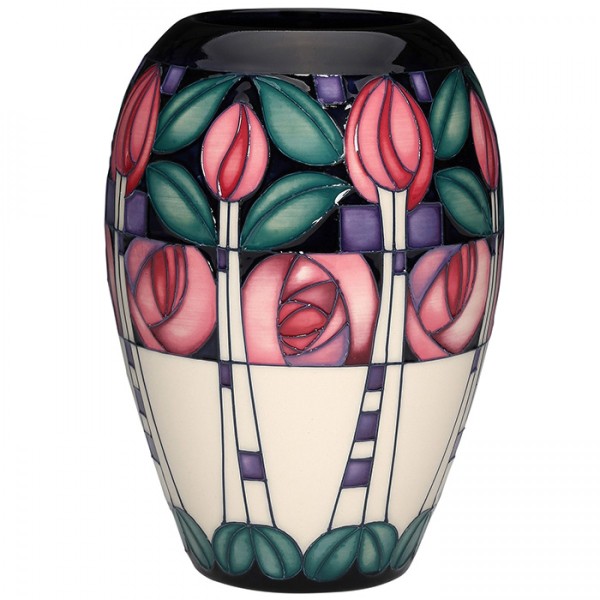Kingsborough Gardens may well be overlooked by many a Moorcroft collector enchanted by the work of the legendary Charles Rennie Mackintosh (1868- 1928), champion of the Art Nouveau design movement. The work undertaken at 14 Kingsborough Gardens by Mackintosh features the birth of the stylised rose that became one of his iconic design motifs and is synonymous with ‘Mackintosh’ style worldwide. It all began in 1902 when Mackintosh designed white-painted fitted and free-standing furniture and stencilled wall decoration for the drawing room at for ship owner Robert James Rowat – cousin of the designer and art school teacher, Jessie Newbery. While serving his apprenticeship in Glasgow, Mackintosh had attended evening classes in architecture at Glasgow School of Art. The School, under the remarkable direction of Francis (Fra) Newbery (1855-1946), was recognized as one of Europe's leading design schools, its main function being to educate industrial artists and ornamentalists. A pair of free-standing cabinets with door panels depicting Mackintosh ladies shrouded in white, each holding aloft a pink rose, were created for 14 Kingsborough Gardens. It is believed that these cabinets would have been placed side-by-side with their doors open showing their stunning interiors. The doors were lined with silver foil inlaid with coloured glass in a stylised design of a lady holding a rose.

Whilst a payment of £40 was made by Mrs Rowat on 10th May 1905 which may relate to this project, many believe that the panels were in fact designed by Charles’s wife, Margaret, who often collaborated with her husband.
Mackintosh had a duplicate pair of cabinets made for his own home in Glasgow, and this pair can be seen on display in ‘The Mackintosh House’ in the Hunterian Museum where they stand flanking one of the fireplaces. It was from 1906 to 1914 that Charles and Margaret transformed their traditional Victorian home into modern minimalism. When the building was demolished in 1963, the University of Glasgow salvaged the interior fixtures — including windows, doors, fireplaces, and staircase — and reassembled the principal rooms inside the Hunterian Art Gallery. Charles and Margaret believed that a room is a work of art — and dedicated their lives in this quest. A simple oak table surrounded by high-backed chairs anchors the dining room, but the walls are truly the centrepiece. A stencilled motif of black trellis and stylized roses interplays with silver dewdrops that reflect light from the chandelier. By contrast, the off-white walls, ceiling, furniture, and rug of the bedroom create a unity interrupted only by stencils of the Glasgow Rose on some furniture. Mackintosh despised clutter and his interior designs held invisible built-in storage units. It is perhaps not the case that he was a stickler for tidiness for the tedious sake of strict discipline alone - it is more the case that he was searching in his work for "the soul that lies beneath appearances" and, he found that this soul was best expressed through a poetic mood of symbolic illumination.

In truth, these two identical cabinets made for their own house adds value to the argument that the Glasgow Rose was a symbol of their love with the artwork achieved by the consummate skills of both parties. As well as featuring the Glasgow Rose, the design also features the heart-shaped leaf motif known as the ‘cicely leaf’ or ‘cecily leaf’. Mackintosh also designed a stencilled wall decoration for the bedroom of the clients’ eleven-year-old daughter, Maud, using grey, pink and green colourway. In honour of the home in which these Mackintosh roses bloomed, Emma has added a band of rich green leaves that add a new colour dimension to the original colour palette of pink and white used in his Glasgow Rose cabinet and also utilise the greenery found in Maud’s bedroom as the Moorcroft design is aptly named Kingsborough Gardens. The leaves are not the ‘cecily leaf’ but contains simple, undivided leaves. A classic Moorcroft dark blue ground completes the design, enabling the Glasgow roses to flower with life for eternity.
Herbert MacNair "Not a line was drawn without purpose, and rarely was a single motif employed that had not some allegorical meaning.”
Source Articles
https://www.mackintosh-architecture.gla.ac.uk/catalogue/pdf/MX.06.pdf University of Glasgow
https://www.mackintosh-architecture.gla.ac.uk/catalogue/browse/display/?sysnum=s904 University of Glasgow
https://artsandculture.google.com/asset/cabinet-designed-for-14-kingsborough-gardens-glasgow-house-of-mrs-robert-j-rowat-white/zQGOD7NiYkdEUQ Google arts and culture
http://repository.nms.ac.uk/1088/1/1088%2014%20Kingsborough%20Gardens%20and%20the%20Patronage%20of%20the%20Rowat%20Family%202.pdf National Museums Scotland
